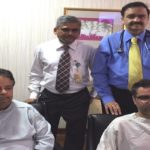India
healthysoch
New Delhi, November 26, 2020:


For an organization that takes pride in making infertility treatment accessible to the remotest parts in India, it is a remarkable moment to look back at Navya’s birth as the beginning of the success story of Indira IVF. Indira IVF has crossed several significant milestones since Navya’s birth on 25 November 2011. With 93 centres across India and after having performed one lakh cycles since its inception, Indira IVF today is the largest and the most recognized and trusted fertility chain of hospitals in the country.
Speaking on the occasion, Dr. Ajay Murdia-Founder and Chairman, Indira IVF said, “It gives us a sense of immense satisfaction and happiness to think of all the families that we have impacted with our work. They placed huge trust in us, and we are happy to deliver on our promise. I would also like to give a word of advice to aspiring couples that for when they see signs of infertility, they should immediately consult with an expert. We should see infertility like any other disease and remember that science has given us solutions to this problem. I wish Navya and her family a fulfilling life.”
Dr. Kshitiz Muridia, Co-founder and CEO of Indira IVF, said that “Navya is a joyous reminder of our focus on successful clinical outcomes, and at Indira we take utmost care to use advanced technologies to help couples become parents. We first introduced closed working chamber IVF technique for our patients for the first time in India in 2011 and recently we introduced electronic witness system to safeguard embryos from mixing. Kavya is our first baby to be born out of closed working chamber”.
He added, “Today the success rate of IVF treatment has improved by leaps and bound with technological advancement as now several couples are able to conceive in the first cycle itself. Earlier it would take close to 2-3 cycles which would financially burden the couple. Technology has made IVF extremely affordable today.”
Throwing light upon the stigma associated with infertility and the work done by Indira IVF, Nitiz Murdia, Co-founder and Director, Indira IVF, remarked “It was brave of Navya’s parents, who hail from a remote place in Barmer, to look towards science for a solution to their secondary infertility, a decade ago. In the last ten years, while we have made infertility treatments more accessible, we are also proud to have made an impact towards eliminating the stigma and myths associated with infertility and IVF treatments. We curated the “Nisantanta Bharat Chhoro” campaign under which we have organized over 2141 awareness camps across 24 states in 746 cities, in the country.”
Navya’s parents, who were also present at the celebrations, said that it was a long journey for them as they weren’t able to conceive even after trying for 10 years. “We went to several cities to seek treatment for our condition but it was Indira IVF at Udaipur that helped us realize our dream of becoming parents to our second child, Navya,” said her parents Hansraj and Rekha Soni.
Armed with state-of-the-art infrastructure, Indira IVF helps countless couples navigate the often-complicated journey of infertility and ultimately realize their dream of starting a family.
healthysoch







